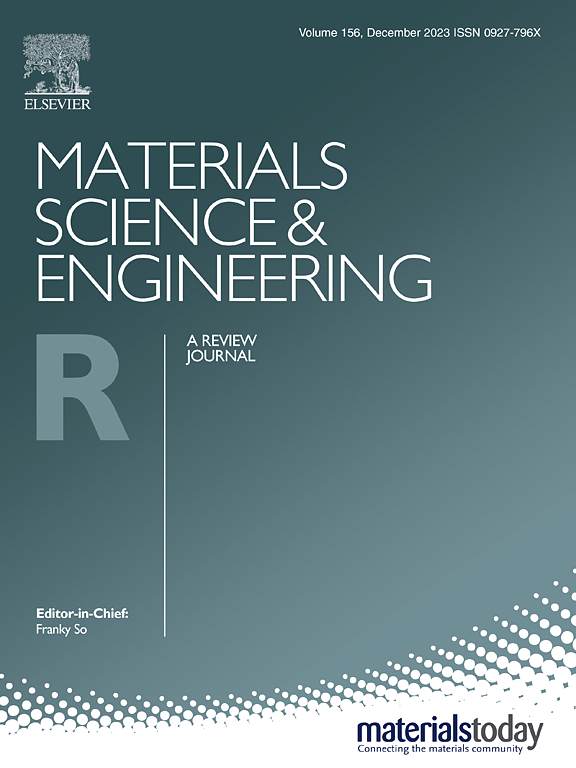Directed charge transfer of Zn-O bridge of atomistic tandem dual Z-scheme heterojunction for photocatalytic CO2 reduction
IF 31.6
1区 材料科学
Q1 MATERIALS SCIENCE, MULTIDISCIPLINARY
引用次数: 0
Abstract
Photocatalytic CO2 reduction (PCR) is limited by unsatisfied activity and selectivity. The integration of molecular photocatalysts with semiconductors can solve the above two issues simultaneously. However, most of the organic-inorganic heterojunctions are bulky-based morphologies, which are still restricted by the control of surface areas and charge transfer. Herein, a tandem dual Z-scheme heterostructure was synthesized by assembling cobalt porphyrin ([meso-tetra (4-sulfonate phenyl) porphyrinato], CoTPPS) on hollow-structured TiO2@ZnIn2S4 (H-TiO2@ZIS). The optimized H-TiO2@ZIS@CoTPPS exhibits superior solar fuel evolution of 158.15 μmolCO g−1·h−1 via the PCR process, which is superior to most reported TiO2 and ZIS-based photocatalysts. The exceptional photocatalytic performance is ascribed to enhanced light absorption, elevated surface areas, directed charge separation, and improved CO2 activation. Specifically, the double built-in electric field (IEF) and the Zn-O bond of dual Z-scheme structures facilitate fast charge separation. Detailed charge transfer dynamics of H-TiO2@ZIS@CoTPPS are investigated by experimental characterizations and density functional theory (DFT) calculations. This investigation provides atomistic insight into unique dual Z-scheme heterostructure and offers a new paradigm for solar-driven energy conversion
原子串联双z方案异质结Zn-O桥的定向电荷转移光催化CO2还原
光催化CO2还原(PCR)技术受到活性和选择性不理想的限制。将分子光催化剂与半导体相结合,可以同时解决上述两个问题。然而,大多数有机-无机异质结是基于体积的形态,仍然受到表面积和电荷转移控制的限制。本文通过在中空结构的TiO2@ZnIn2S4 (H-TiO2@ZIS)上组装卟啉钴([中位四(4-磺酸苯基)卟啉],CoTPPS),合成了串联双z型异质结构。优化后的H-TiO2@ZIS@CoTPPS通过PCR工艺表现出158.15 μmolCO g−1·h−1的优异太阳能燃料演化性能,优于大多数报道的TiO2和zis基光催化剂。优异的光催化性能归功于增强的光吸收、提高的表面积、定向电荷分离和改善的CO2活化。具体来说,双内置电场(IEF)和双Z-scheme结构的Zn-O键促进了电荷的快速分离。通过实验表征和密度泛函理论(DFT)计算研究了H-TiO2@ZIS@CoTPPS的详细电荷转移动力学。这项研究为独特的双z型异质结构提供了原子视角,并为太阳能驱动的能量转换提供了新的范例
本文章由计算机程序翻译,如有差异,请以英文原文为准。
求助全文
约1分钟内获得全文
求助全文
来源期刊

Materials Science and Engineering: R: Reports
工程技术-材料科学:综合
CiteScore
60.50
自引率
0.30%
发文量
19
审稿时长
34 days
期刊介绍:
Materials Science & Engineering R: Reports is a journal that covers a wide range of topics in the field of materials science and engineering. It publishes both experimental and theoretical research papers, providing background information and critical assessments on various topics. The journal aims to publish high-quality and novel research papers and reviews.
The subject areas covered by the journal include Materials Science (General), Electronic Materials, Optical Materials, and Magnetic Materials. In addition to regular issues, the journal also publishes special issues on key themes in the field of materials science, including Energy Materials, Materials for Health, Materials Discovery, Innovation for High Value Manufacturing, and Sustainable Materials development.
 求助内容:
求助内容: 应助结果提醒方式:
应助结果提醒方式:


